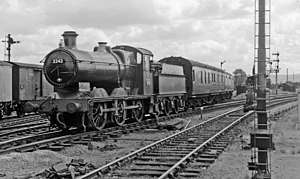GWR 2251 Class
The Great Western Railway (GWR) 2251 Class was a class of 0-6-0 steam tender locomotive designed for medium-powered freight. They were introduced in 1930 as a replacement for the earlier Dean Goods 0-6-0s and built up to 1948.[1]
| GWR 2251 Class | |||||||||||||||||||||||||||||||||||||||||||||||||||
|---|---|---|---|---|---|---|---|---|---|---|---|---|---|---|---|---|---|---|---|---|---|---|---|---|---|---|---|---|---|---|---|---|---|---|---|---|---|---|---|---|---|---|---|---|---|---|---|---|---|---|---|
 2242 at Tramway Junction, Gloucester | |||||||||||||||||||||||||||||||||||||||||||||||||||
| |||||||||||||||||||||||||||||||||||||||||||||||||||
| |||||||||||||||||||||||||||||||||||||||||||||||||||
| |||||||||||||||||||||||||||||||||||||||||||||||||||
| |||||||||||||||||||||||||||||||||||||||||||||||||||
Overview
In many ways, the 2251s were modernised Dean Goods, sharing the main dimensions, but having more modern features such as taper boilers and full cabs. Increases in both boiler pressure and heating surface gave a useful increase in power at the expense of weight that restricted permitted routes. Numbers 2211–2230, built in 1940 did not have side windows. Designed by Charles Collett for medium freight and passenger duties they had 5 ft 2 in (1.575 m) driving wheels. Carrying a maximum of 3,000 imperial gallons (14,000 l; 3,600 US gal) of water to fuel a boiler operating at 200 psi (1.4 MPa) they developed 20,155 lbf (89.65 kN) of tractive effort. They could be found operating on most parts of the former GWR system. These were the first GWR 0-6-0 to use the standard number 10 boiler as later fitted to the 94xx, 15xx and various rebuilds of absorbed mainly Welsh locomotives.
They were withdrawn between 1958 and 1965.
Preservation
.jpg)
One, 3205, has been preserved and is located on the South Devon Railway in Devon.[2]
Models
Bachmann Branchline manufactures models of the 2251 in OO gauge. Mainline (Palitoy) released the first ready-to-run OO model in 1978. The Bachmann model was released in 1996. It is based on the Mainline model with revised body tooling to complement a completely new chassis design that allows the boiler backhead to be modelled.
In N gauge, the first model was the langley whitemetal kit, designed to fit the graham farish 94xx/general purpose tank chassis. The next was the Peco (model railroads) ready to run model. This was a big step forward, and was DCC fitted as standard. Production of these stopped around 2010. The next model of the class was made by Union Mills, and was released in 2017.
In 3mm/TT scale , BEC produced a whitemetal kit body for the Tri-ang jinty chassis, though this is long discontinued.
References
- "Digital Traction GWR Collett 0-6-0 '2251' Class". Steam Sounds Supreme. Retrieved 13 September 2017.
- "GWR 0-6-0 No 3205". South Devon Railway. Retrieved 14 September 2019.
- Whitehurst, Brian (1973). Great Western Engines, Names, Numbers, Types and Classes (1940 to Preservation). Oxford, UK: Oxford Publishing Company. pp. 23–24, 30, 102, 127. ISBN 978-0-9028-8821-0. OCLC 815661.
External links
| Wikimedia Commons has media related to GWR 2251 Class. |